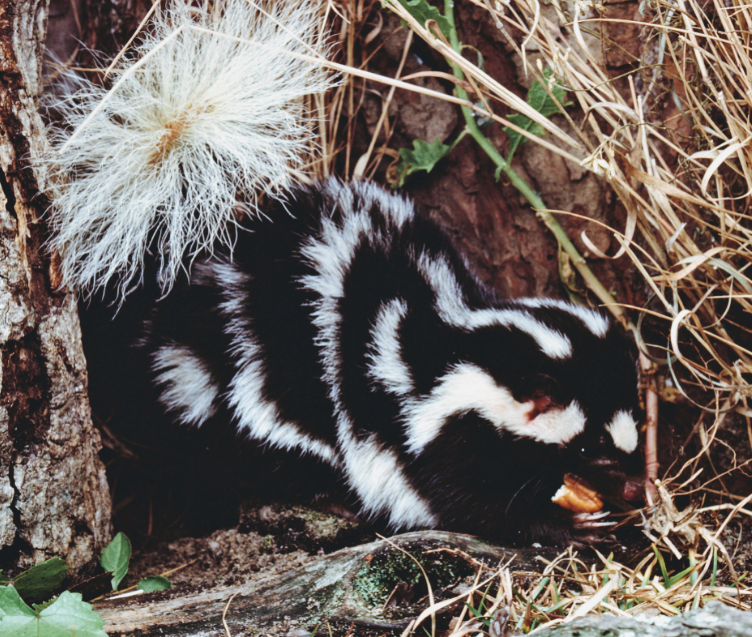
Spotted skunk DNA helps identify new species
Spotted skunks are found throughout North America but have not been well studied. This is partly because they spray their noxious odor at researchers who try to catch them, but also because they are nocturnal, usually occur in remote areas and are very agile tree climbers. Until recently, it was not even known how many species of spotted skunks exist in the wild.
Weighing in at less than two pounds, spotted skunks are smaller than their striped cousins. They also have spots on their backs, although these are actually formed by white stripes that are disrupted by black coloration along their length. Spotted skunks have a characteristic way of dispensing their smelly spray, too – they do a handstand before release, lifting their hind legs and bushy tail into the air in a menacing display.
In the past, the number of spotted skunk species has increased as biologists learn more about these small animals. Ever since Carl Linnaeus first described a specimen in 1758, researchers have struggled to decide whether the many different forms are subspecies or full species. More recently, scientists agreed that there are four separate species.
However, new research published in the journal Molecular Phylogenetics and Evolution used an analysis of skunk DNA to establish that there are actually seven species of spotted skunks.
According to Adam Ferguson, one of the paper’s authors and the Negaunee collections manager of mammals at Chicago’s Field Museum, the study was likely to turn up some interesting results as there are many skunk populations that are geographically isolated and morphologically distinct.
“We figured there had to be some surprises when it came to spotted skunk diversity, because the genus as a whole had never been properly analyzed using genetic data,” said Ferguson.
The researchers obtained spotted skunk DNA samples using a variety of methods. In addition to collecting tissue from skunks that they captured, they also distributed “wanted” posters asking the public to inform them when spotted skunks were trapped or killed on the road. Tissue from museum specimens helped to fill in the gaps when they had no modern tissue samples, as was the case for skunks from Central America and the Yucatan Peninsula. In total, 203 samples were collected for DNA analysis.
A comparison of the DNA sequences indicated that skunks can be grouped into seven distinct species; some species that had been lumped together previously were significantly different and warranted separate species status. The researchers consequently resurrected some species names that hadn’t been used in centuries.
“I was able to extract DNA from century-old museum samples and it was really exciting to see who those individuals were related to. It turns out that one of those was a currently unrecognized, endemic species in the Yucatan,” says study first author Molly McDonough, a professor of Biology at Chicago State University and a research associate at the Field Museum.
The Yucatan spotted skunk and the Plains spotted skunk were among the new species described as a consequence of the DNA analysis in this study. Plains spotted skunks used to inhabit the central plains of the US, from Texas to Wyoming, but have been declining over the past century due to threats such as habitat loss, food shortage resulting from the use of pesticides, and mortality due to vehicle strikes.
It is important for conservationists to know whether a population of skunks is a full species or a subspecies, and this recent study has helped to define the status of the spotted skunk populations more clearly.
“If a subspecies is in trouble, there’s sometimes less emphasis on protecting it because it’s not as distinct an evolutionary lineage as a species,” says Ferguson. “We’ve shown that the Plains spotted skunks are distinct at the species level, which means they’ve been evolving independently of the other skunks for a long time. Once something has a species name, it’s easier to conserve and protect.”
Although skunks generally are maligned mammals, they play important roles in ecosystems, and protecting them from extinction is critical. Now that scientists know the evolutionary relationships between skunk species, they will be able to advise more accurately about management and conservation programs.
“By analyzing the genome of spotted skunks, we’ve been able to learn that their evolution and splitting into different species was driven by climate change during the Ice Age,” says Ferguson. “The different lineages we found might help us find different conservation angles for protecting them in the future.”
—
By Alison Bosman, Earth.com Staff Writer












